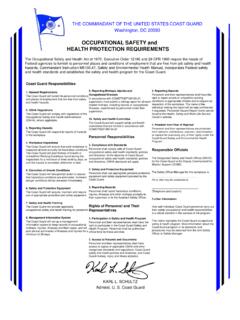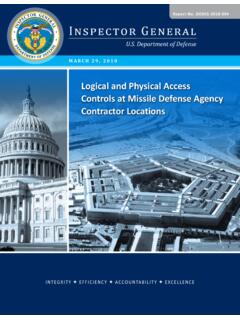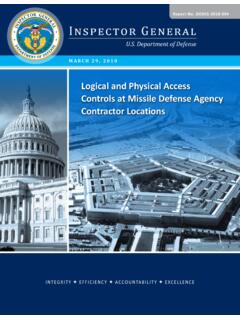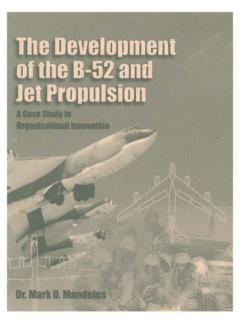Transcription of DEFENSE INTELLIGENCE BALLISTIC MISSILE ANALYSIS …
1 DEFENSE INTELLIGENCE BALLISTIC MISSILE ANALYSIS COMMITTEE 2 KEY FINDINGS Many countries view BALLISTIC and cruise MISSILE systems as cost-effective weapons and symbols of national power, especially when those systems are armed with weapons of mass destruction. However, numerous types of BALLISTIC and cruise missiles have achieved dramatic improvements in accuracy that allow them to be used effectively with conventional warheads. Some weapon systems have characteristics of both BALLISTIC and cruise missiles.
2 For example, BALLISTIC MISSILE -launched hypersonic glide vehicles (HGVs) can maneuver in the atmosphere similar to cruise missiles, and future supersonic/hypersonic cruise missiles may be launched by large rocket boosters. Highly accurate BALLISTIC and cruise missiles can be used to deter or counter adversary forces deploying to or operating within a defined space or theater. NORTH KOREA North Korea has a strong desire to develop long-range BALLISTIC MISSILE systems that can threaten the United States and its allies.
3 During a 2012 military parade, North Korea unveiled its first intercontinental BALLISTIC MISSILE (ICBM), the Hwasong-13, and subsequently debuted the Hwasong-14 ICBM in an October 2015 parade. Flight testing of the Hwasong-10 (Musudan) intermediate-range BALLISTIC MISSILE (IRBM) began in April 2016 with a series of failures. North Korea followed those failures by launching multiple new missiles in 2017. In April 2017, North Korea also commenced flight testing of a new liquid-propellant IRBM, the Hwasong-12. That same year, North Korea performed the inaugural flight tests of the Hwasong-14 and Hwasong-15 ICBMs.
4 Upon its launch in 2017, the Hwasong-14 marked the first flight-tested ICBM-class MISSILE for North Korea. North Korea also flight tested several new solid-propellant missiles including the Pukguksong-1 submarine-launched BALLISTIC MISSILE (SRBM), the Pukguksong-2 medium-range BALLISTIC MISSILE (MRBM), and short-range BALLISTIC missiles (SRBM) - in 2016, 2017, and 2019, respectively. IRAN Tehran s desire to have a strategic counter to the United States could drive it to field an ICBM. Progress in Iran s space program could shorten a pathway to an ICBM, because space launch vehicles (SLV) use inherently similar technologies.
5 Since 2008, Iran has conducted multiple launches of the two-stage Safir SLV, and the larger two-stage Simorgh SLV, which could serve as a test bed for developing ICBM technologies. Iran has developed the Qiam-1 SRBM and the fourth-generation Fateh-110 SRBM, and Tehran claims to be mass-producing BALLISTIC missiles capable of striking ships. Iran has modified its Shahab 3 MRBM to extend its range and effectiveness and also claims to have deployed the two-stage, solid-propellant Sejjil MRBM. In 2015, Iran publicized the launch of the Emad-1, which officials claim is Iran s first long-range MISSILE that is guided throughout flight and capable of hitting its targets with high-precision.
6 Iranian officials have also announced plans for an Emad-2 with greater precision, as well as a new Sejjil that can be guided all the way to the target. In 2019, Iran publicized the launch of the Khorramshahr-2, which officials claim is Iran s deadliest long-range MISSILE , using the fins installed on the warhead to enable guidance throughout flight. Iran is also developing a ground-launched land-attack cruise MISSILE (LACM). CHINA China continues to have the most active and diverse BALLISTIC MISSILE development program in the world.
7 It is developing and testing offensive missiles, forming additional MISSILE units, upgrading MISSILE systems, and developing methods to counter BALLISTIC MISSILE Russia SS-27 ICBM TEL 3 defenses. China s deployed BALLISTIC MISSILE force, operated by the People s Liberation Army (PLA) Navy and PLA Rocket Force (formerly known as Second Artillery), is expanding in both number and diversity of system. China continues to field conventionally-armed SRBMs such as the CSS-6 (DF-15) and the CSS-7 (DF-11) opposite Taiwan, and has developed a number of mobile, conventionally-armed MRBMs and IRBMs.
8 Missiles such as the CSS-11 (DF-16), CSS-22 (DF-17), CSS-5 Mod 4 (DF-21C) and Mod 5 (DF-21D), and CSS-18 (DF-26) are key components of the Chinese military modernization program, specifically designed to prevent adversary military forces access to regional conflicts. The CSS-5 Mod 5 and a variant of the CSS-18 have anti-ship missions. China is also developing a shipborne anti ship BALLISTIC MISSILE (ASBM) for export. China has ground and air-launched LACMs. China s nuclear-armed MISSILE force is also expanding with the number of Chinese ICBM nuclear warheads capable of reaching the United States potentially expanding to well over 200 within the next 5 years.
9 China is adding the CSS-10 Mod 2 (DF-31A) and CSS-4 Mod 3 (DF-5B) to the ICBM force; the DF-5B is China s first ICBM with multiple independently-targetable reentry vehicles (MIRVs). The CSS-N-14 SLBM gives China its first long-range, sea-based nuclear capability. China is also developing the CSS-20 (DF-41), a new MIRV-capable, road-mobile ICBM and the DF-31AG road-mobile ICBM. China attributed both nuclear and conventional missions to the CSS-18 displayed for the first time during the Victory Day Parade in September 2015.
10 RUSSIA Russia has approximately 1,400 deployed nuclear warheads on ICBMs and SLBMs capable of reaching the United States. Despite arms control limitations and resource constraints, development of new ICBM and SLBM systems is proceeding, and Russia is expected to retain the largest force of strategic BALLISTIC missiles outside the United States. Testing of equipment associated with RS-26 Rubezh, which according to the Strategic Rocket Forces commander is based on the SS-27 ICBM, continued in 2018. The BULAVA SLBM was deployed on the new DOLGORUKIY-class SSBNs.














